| Listing 1 - 10 of 10 |
Sort by
|
Book
ISBN: 9781400884186 1400884187 Year: 2016 Publisher: Princeton, NJ : Princeton University Press,
Abstract | Keywords | Export | Availability | Bookmark
 Loading...
Loading...Choose an application
- Reference Manager
- EndNote
- RefWorks (Direct export to RefWorks)
This book offers a concise introduction to the angular momentum, one of the most fundamental quantities in all of quantum mechanics. Beginning with the quantization of angular momentum, spin angular momentum, and the orbital angular momentum, the author goes on to discuss the Clebsch-Gordan coefficients for a two-component system. After developing the necessary mathematics, specifically spherical tensors and tensor operators, the author then investigates the 3-j, 6-j, and 9-j symbols. Throughout, the author provides practical applications to atomic, molecular, and nuclear physics. These include partial-wave expansions, the emission and absorption of particles, the proton and electron quadrupole moment, matrix element calculation in practice, and the properties of the symmetrical top molecule.
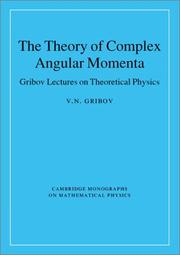
ISBN: 1107135451 1280434597 9786610434596 0511206070 0511169965 0511061374 0511297092 0511534957 0511069839 9780511061370 9780511069833 9780511534959 0521818346 9780521818346 9780511055041 0511055048 9781107135451 9781280434594 661043459X 9780511206078 9780511169960 9780511297090 9780521037037 Year: 2003 Publisher: Cambridge ; New York : Cambridge University Press,
Abstract | Keywords | Export | Availability | Bookmark
 Loading...
Loading...Choose an application
- Reference Manager
- EndNote
- RefWorks (Direct export to RefWorks)
This 2003 book provides a rigorous introduction to the theory of complex angular momenta, based on the methods of field theory. It comprises an English translation of the series of lectures given by V. N. Gribov in 1969, when the physics of high-energy hadron interactions was being created. Besides their historical significance, these lectures contain material which is highly relevant to research today. The basic physical results and the approaches Gribov developed are now being rediscovered in an alternative context: in the microscopic theory of hadrons provided by quantum chromodynamics. The ideas and calculation techniques presented in this book are useful for analysing high-energy hadron scattering phenomena, deep inelastic lepton-hadron scattering, the physics of heavy ion collisions, kinetic phenomena in phase transitions, and will be instrumental in the analysis of electroweak processes at the next-generation particle accelerators, such as LHC and TESLA.
Angular momentum (Nuclear physics). --- Quantum field theory. --- Angular momentum (Nuclear physics) --- Quantum field theory --- Nuclear Physics --- Physics --- Physical Sciences & Mathematics --- Relativistic quantum field theory --- Field theory (Physics) --- Quantum theory --- Relativity (Physics) --- Angular momentum --- Nuclear moments
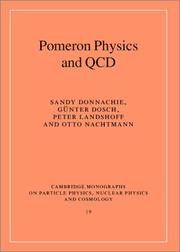
ISBN: 1107128978 1280417889 9786610417889 1139146394 0511169957 0511066813 0511060505 0511297084 0511534930 0511068948 9780511066818 9780511534935 052178039X 9780521780391 9780521675703 0521675707 9781107128972 9781280417887 6610417881 9781139146395 9780511169953 9780511060502 9780511297083 9780511068942 Year: 2002 Publisher: New York : Cambridge University Press,
Abstract | Keywords | Export | Availability | Bookmark
 Loading...
Loading...Choose an application
- Reference Manager
- EndNote
- RefWorks (Direct export to RefWorks)
This book describes the underlying ideas and modern developments of Regge theory, confronting the theory with quantum chromodynamics and a huge variety of experimental data. It covers forty years of research and provides a unique insight into the theory and its phenomenological development. The authors review experiments that suggest the existence of a soft pomeron, and give a detailed discussion of attempts at describing this through nonperturbative quantum chromodynamics. They suggest that a second, hard pomeron is responsible for the dramatic rise in energy observed in deep inelastic lepton scattering. The two-pomeron hypothesis is applied to a variety of interactions and is compared and contrasted with perturbative quantum chromodynamics, as well as with the dipole approach. This book will provide a valuable reference for experimental particle physicists all over the world. It is also suitable for graduate courses in particle physics, high-energy scattering, QCD and the standard model.
Regge theory. --- Pomerons. --- Quantum chromodynamics. --- Chromodynamics, Quantum --- QCD (Nuclear physics) --- Particles (Nuclear physics) --- Quantum electrodynamics --- Pomeranchuk particles --- Pomeranchuk poles --- Pomeranchuk trajectories --- Angular momentum (Nuclear physics)
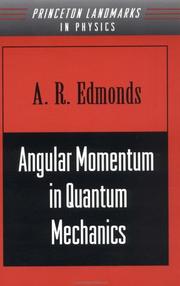
ISBN: 0691025894 1400884187 0691079129 Year: 2016 Publisher: Princeton, NJ : Princeton University Press,
Abstract | Keywords | Export | Availability | Bookmark
 Loading...
Loading...Choose an application
- Reference Manager
- EndNote
- RefWorks (Direct export to RefWorks)
This book offers a concise introduction to the angular momentum, one of the most fundamental quantities in all of quantum mechanics. Beginning with the quantization of angular momentum, spin angular momentum, and the orbital angular momentum, the author goes on to discuss the Clebsch-Gordan coefficients for a two-component system. After developing the necessary mathematics, specifically spherical tensors and tensor operators, the author then investigates the 3-j, 6-j, and 9-j symbols. Throughout, the author provides practical applications to atomic, molecular, and nuclear physics. These include partial-wave expansions, the emission and absorption of particles, the proton and electron quadrupole moment, matrix element calculation in practice, and the properties of the symmetrical top molecule.
Momemt angulaire (Physique nucléaire) --- Momemt angulaire (Physique nucléaire) --- Angular momentum (Nuclear physics) --- 530.145 --- Angular momentum --- Nuclear moments --- 530.145 Quantum theory --- Quantum theory --- #WSCH:AAS1 --- #WSCH:AAS2 --- Quantum theory.
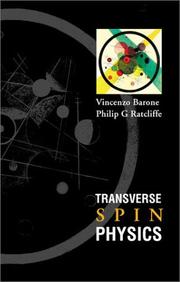
ISBN: 1281935875 9786611935870 9812795510 9789812795519 9781281935878 6611935878 9789812381019 9812381015 Year: 2003 Publisher: River Edge, N.J. : World Scientific,
Abstract | Keywords | Export | Availability | Bookmark
 Loading...
Loading...Choose an application
- Reference Manager
- EndNote
- RefWorks (Direct export to RefWorks)
This book is devoted to the theory and phenomenology of transverse-spin effects in high-energy hadronic physics. Contrary to common past belief, it is now rather clear that such effects are far from irrelevant. A decade or so of intense theoretical work has shed much light on the subject and brought to surface an entire class of new phenomena, which now await thorough experimental investigation. Over the next few years a number of experiments world-wide (at BNL, CERN, DESY and JLAB) will run with transversely polarised beams and targets, providing data that will enrich our knowledge of the transverse-spin structure of hadrons. It is therefore timely to assess the state of the art, and this is the principal aim of the volume. An outline of the book is as follows. After a few introductory remarks (Chapter 1), attention is directed in Chapter 2 to transversely polarised deeply-inelastic scattering (DIS), which probes the transverse spin structure function g2. This existing data are reviewed and discussed (for completeness, a brief presentation of longitudinally polarised DIS is also provided). In Chapter 3 the transverse-spin structure of the proton is illustrated in detail, with emphasis on the transversity distribution and the twist-three parton distribution contributing to g2. Model calculations of these quantities are also presented. In Chapter 4, the QCD evolution of transversity is studied at leading and next-to-leading order. Chapter 5 illustrates the g2 structure function and its related sum rules within the framework of perturbative QCD. The last three chapters are devoted to the phenomenology of transversity, in the context of Drell-Yan processes (Chapter 6), inclusive leptoproduction (Chapter 7) and inclusive hadroproduction (Chapter 8). The interpretation of some recent single-spin asymmetry data is discussed and the prospects for future measurements are reviewed.
High spin physics. --- Nuclear spin. --- Hadrons. --- Strongly interacting particles --- Particles (Nuclear physics) --- Partons --- Spin, Nuclear --- Angular momentum (Nuclear physics) --- Nuclear physics --- High energy spin physics --- High spin nuclear levels --- High spin states (Physics)
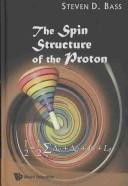
ISBN: 1281918814 9786611918811 9812709487 9789812709486 9781281918819 9812709460 9789812709462 9812709479 9789812709479 6611918817 Year: 2008 Publisher: Singapore ; Hackensack, NJ : World Scientific,
Abstract | Keywords | Export | Availability | Bookmark
 Loading...
Loading...Choose an application
- Reference Manager
- EndNote
- RefWorks (Direct export to RefWorks)
Protons. --- Nuclear spin. --- Quark models. --- Quantum chromodynamics. --- Chromodynamics, Quantum --- QCD (Nuclear physics) --- Particles (Nuclear physics) --- Quantum electrodynamics --- Models, Quark --- Nuclear models --- Spin, Nuclear --- Angular momentum (Nuclear physics) --- Nuclear physics --- Hydrogen nucleus --- Atoms --- Baryons --- Matter --- Constitution
Book
ISBN: 9781009290111 9781009290104 9781009290128 Year: 2022 Publisher: Cambridge : Cambridge University Press,
Abstract | Keywords | Export | Availability | Bookmark
 Loading...
Loading...Choose an application
- Reference Manager
- EndNote
- RefWorks (Direct export to RefWorks)
This volume describes the Pomeron, an object of crucial importance in very high energy particle physics. Starting with a general description of the Pomeron within the framework of Regge theory, the emergence of the Pomeron within scalar field theory is discussed, providing a natural foundation on which to develop the more realistic case of QCD. The reggeization of the gluon is demonstrated and used to build the Pomeron of perturbative QCD. The dynamical nature of the Pomeron and its role in small-x deep inelastic scattering and in diffractive scattering is also examined in detail. The volume concludes with a study of the colour dipole approach to high energy scattering and the explicit role of unitarity corrections. This book will be of interest to theoretical and experimental particle physicists, and applied mathematicians. First published in 1997, this title has been reissued as an Open Access publication on Cambridge Core.
Regge theory. --- Pomerons. --- Quantum chromodynamics. --- Perturbation (Quantum dynamics) --- Perturbation theory, Quantum mechanical --- Perturbation (Mathematics) --- Quantum theory --- Chromodynamics, Quantum --- QCD (Nuclear physics) --- Particles (Nuclear physics) --- Quantum electrodynamics --- Pomeranchuk particles --- Pomeranchuk poles --- Pomeranchuk trajectories --- Angular momentum (Nuclear physics)
Book
ISBN: 0444594140 0444594116 9780444594143 1299666434 9781299666436 9780444594112 Year: 2013 Publisher: Amsterdam : Elsevier,
Abstract | Keywords | Export | Availability | Bookmark
 Loading...
Loading...Choose an application
- Reference Manager
- EndNote
- RefWorks (Direct export to RefWorks)
The progress in nuclear magnetic resonance (NMR) spectroscopy that took place during the last several decades is observed in both experimental capabilities and theoretical approaches to study the spectral parameters. The scope of NMR spectroscopy for studying a large series of molecular problems has notably broadened. However, at the same time, it requires specialists to fully use its potentialities. This is a notorious problem and it is reflected in the current literature where this spectroscopy is typically only used in a routine way. Also, it is seldom used in several disciplines in whic
Chemistry, Organic. --- Nuclear magnetic resonance. --- Spectroscopy. --- Nuclear magnetic resonance spectroscopy --- Molecular structure --- Nuclear magnetic resonance --- Spectrum analysis --- Chemistry, Organic --- Chemistry --- Physics --- Physical Sciences & Mathematics --- Electricity & Magnetism --- Analytical Chemistry --- Nuclear magnetic resonance spectroscopy. --- Nuclear spin. --- Spin, Nuclear --- Angular momentum (Nuclear physics) --- Nuclear physics --- NMR spectroscopy --- Spectroscopy, NMR --- Spectroscopy, Nuclear magnetic resonance --- Nuclear spectroscopy --- Knight shift
Book
ISBN: 1536103004 9781536103007 9781536103007 9781536102765 Year: 2017 Publisher: Hauppauge, New York : Nova Science Publishers, Incorporated,
Abstract | Keywords | Export | Availability | Bookmark
 Loading...
Loading...Choose an application
- Reference Manager
- EndNote
- RefWorks (Direct export to RefWorks)
Fermions. --- Scattering (Physics) --- Magnetic structure. --- Nuclear spin. --- Nanostructured materials. --- Nanomaterials --- Nanometer materials --- Nanophase materials --- Nanostructure controlled materials --- Nanostructure materials --- Ultra-fine microstructure materials --- Microstructure --- Nanotechnology --- Spin, Nuclear --- Angular momentum (Nuclear physics) --- Nuclear physics --- Structure, Magnetic --- Crystallography --- Nuclear spin --- Atomic scattering --- Atoms --- Nuclear scattering --- Particles (Nuclear physics) --- Scattering of particles --- Wave scattering --- Collisions (Nuclear physics) --- Particles --- Collisions (Physics) --- Fermi-Dirac particles --- Quantum statistics --- Interacting boson-fermion models --- Leptons (Nuclear physics) --- Scattering
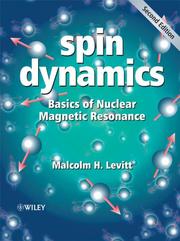
ISBN: 9780470511176 9780470511183 0470511184 0470511176 Year: 2012 Publisher: Chichester: Wiley,
Abstract | Keywords | Export | Availability | Bookmark
 Loading...
Loading...Choose an application
- Reference Manager
- EndNote
- RefWorks (Direct export to RefWorks)
Nuclear spin --- Nuclear magnetic resonance --- Nuclear spin. --- Nuclear magnetic resonance. --- Spin nucléaire --- Résonance magnétique nucléaire --- 543.08 --- 543.422.25 --- 543.42 --- Magnetic resonance, Nuclear --- NMR (Nuclear magnetic resonance) --- Nuclear spin resonance --- Resonance, Nuclear spin --- Magnetic resonance --- Nuclear quadrupole resonance --- Spin, Nuclear --- Angular momentum (Nuclear physics) --- Nuclear physics --- 543.08 Analytical measurement --- Analytical measurement --- 543.42 Spectrum analysis. Spectroscopy. Spectrography. Spectrometry. Spectrophotometry. Fluorescence analysis --- Spectrum analysis. Spectroscopy. Spectrography. Spectrometry. Spectrophotometry. Fluorescence analysis --- 543.422.25 Using high frequency electromagnetic waves (radio waves). Nuclear manetic resonance spectroscopy. NMR spectroscopy --- Using high frequency electromagnetic waves (radio waves). Nuclear manetic resonance spectroscopy. NMR spectroscopy --- Spin --- Résonance magnétique nucléaire
| Listing 1 - 10 of 10 |
Sort by
|

 Search
Search Feedback
Feedback About UniCat
About UniCat  Help
Help News
News